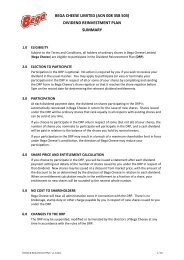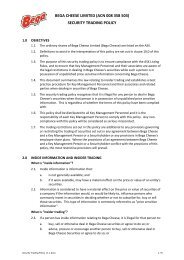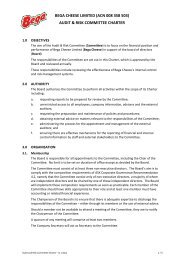Annual Report - Bega Cheese
Annual Report - Bega Cheese
Annual Report - Bega Cheese
You also want an ePaper? Increase the reach of your titles
YUMPU automatically turns print PDFs into web optimized ePapers that Google loves.
Financial Statements<br />
Financial Period Ended Statements 30 June 2010<br />
Period Notes to Ended the Financial 30 June 2010 Statements<br />
Notes to the Financial Statements<br />
z. New Accounting Standards and Interpretations<br />
Certain new accounting standards and interpretations have been published that are not mandatory for 30 June 2010<br />
reporting periods. The Group's and the parent entity's assessment of the impact of these new standards and interpretations<br />
is set out below.<br />
i. AASB 9 replaces the multiple classification and measurement models in AASB 139 Financial instruments: Recognition<br />
and measurement with a single model that has only two classification categories: amortised cost and fair value.<br />
The Group intends to apply the revised standard from 1 July 2013.<br />
ii. AASB 2009-5 Further amendments arising from the 2nd improvements project. The improvements project is an annual<br />
project that provides a mechanism for making non-urgent changes to IFRSs. The changes include editorial and<br />
accounting changes across a great number of standards.<br />
iii. Amendments arising from the third annual improvements project. The annual improvements process provides a<br />
vehicle for making non-urgent but necessary amendments to IFRSs. Amendments affect six standards and one IFRIC:<br />
IFRS 1, IFRS 3, IFRS 7, IAS 1, IAS 27, IAS 34 and IFRIC 13.<br />
The Group intends to monitor the amendments going forward.<br />
2. Financial Risk Management<br />
The Group’s activities expose it to a variety of financial risks; market risks including currency risk, interest rate risk and price<br />
risk. The Group’s overall risk management program focuses on the unpredictability of financial markets and seeks to<br />
minimise potential adverse effects on the financial performance of the Group. The Group uses derivative financial<br />
instruments such as foreign exchange contracts and interest rate swaps to hedge certain risk exposures. Derivatives are<br />
exclusively used for hedging purposes, i.e. not as trading or other speculative instruments. The Group uses different<br />
methods to measure different types of risk to which it is exposed. These methods include sensitivity analysis in case of<br />
interest rate, foreign exchange and other price risks and aging analysis for credit risk.<br />
Risk management is carried out by the treasury function within the finance department under policies approved by the Board<br />
of Directors and overseen by the Finance Committee. The officer identifies, evaluates and hedges financial risks in close cooperation<br />
with the Group’s operating units, by applying principals provided by the Board who have overall responsibility for<br />
risk management. The Board also approve policies covering specific areas, such as foreign exchange risk, interest rate risk,<br />
credit risk, use of financial instruments, and investment of excess liquidity.<br />
a. Market Risk<br />
The Group’s activities expose it primarily to market risks in relation to foreign currency and interest rate movements. The<br />
Group enters into a variety of derivative financial instruments to manage exposures which include; forward foreign currency<br />
contracts to hedge exchange rate risks from the sale of exported goods; interest rate swaps to hedge the fair value risk<br />
associated with fluctuating interest rates.<br />
Foreign Exchange Risk<br />
Foreign exchange risk arises from future commercial transactions and recognised assets and liabilities denominated in a<br />
currency that is not the entity’s functional currency. The Group exports dairy products and is exposed to foreign exchange<br />
risk, primarily the US dollar and Japanese Yen. The risk is measured using sensitivity analysis and cash flow forecasting,<br />
forward contracts are used to manage these risks.<br />
The Group’s risk management policy is to match highly probable future cash flows in foreign currencies, for cash flow hedge<br />
accounting purposes, with forward exchange contracts in the same currency and with closely corresponding settlement<br />
dates. 30-80% of its estimated foreign currency exposures in respect of forecast sales over the subsequent 12 months are<br />
hedged.<br />
<strong>Bega</strong> <strong>Cheese</strong> Limited 2010 <strong>Annual</strong> <strong>Report</strong> 25<br />
<strong>Bega</strong> <strong>Cheese</strong> Limited 2010 <strong>Annual</strong> <strong>Report</strong> 25












